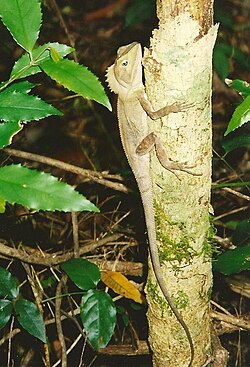Lophosaurus spinipes
| Southern angle-headed dragon | |
|---|---|

| |
| Southern angle-headed dragon - Boorganna Nature Reserve, near Taree, New South Wales, Australia | |
| Scientific classification | |
| Kingdom: | |
| Phylum: | |
| Subphylum: | |
| Class: | |
| Order: | |
| Suborder: | |
| Family: | |
| Subfamily: | |
| Genus: | |
| Species: | L. spinipes
|
| Binomial name | |
| Lophosaurus spinipes (A.M.C. Duméril & A.H.A. Duméril, 1851)
| |
The southern angle-headed dragon or southern forest dragon (Lophosaurus spinipes, formerly Hypsiluris spinipes) is a species of agamid lizard endemic to Australia.[1]
Geographic range
L. spinipes is native to eastern Australian rainforests and rainforest margins from around Gosford in New South Wales to near Gympie in Queensland. It is also present in Barrington Tops National Park, New South Wales.
Description
The southern angle-headed dragon has a large and continuous nuchal crest with a moderately large vertebral crest. The angular brow is pronounced on both adults and juveniles. The snout to vent length is around 110 to 150 mm (4.3 to 5.9 in), additionally there is a long tail which takes the total length to 350 mm (14 in).
The colour varies from shades of brown, grey and green. Patterns where present consist of various irregular mottling, blotches and variegations.
Behaviour
The southern angle-headed dragon is cryptic, slow moving and well camouflaged. Sometimes encountered basking in sunlight after rain. Often perching on buttresses, sapling stems or old stumps. They tend not to dash for cover, but slide discreetly out of view.
Diet
The diet includes insects and other arthropods such as spiders and centipedes.
Reproduction
Eggs are laid in shallow nests in rainforest clearings, including road edges and walking tracks. There is some evidence that they will occasionally lay communal nests. The eggs are vulnerable to predation, particularly by goannas.
References
- ^ Denzer, Wolfgang; Manthey, Ulrich. "Remarks on the taxonomy and nomenclature of the genus Hypsilurus Peters, 1867 (Reptilia, Agamidae, Amphibolurinae)". Zoosystematics and Evolution. 92 (1): 103–110. doi:10.3897/zse.92.7469. ISSN 1860-0743.
{{cite journal}}: CS1 maint: unflagged free DOI (link)
- A Complete Guide to Reptiles of Australia - Steve Wilson & Gerry Swan ISBN 1-876334-72-X
- http://www.australianreptilepark.com.au
- Lophosaurus spinipes at the Reptarium.cz Reptile Database

